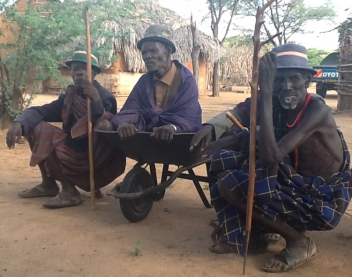 At HelpAge, we work to ensure all older people have a regular and predictable income. However, we found recently in Pakistan that the US$180 grants we were giving older people to restart their livelihoods, were too small to be effective.
At HelpAge, we work to ensure all older people have a regular and predictable income. However, we found recently in Pakistan that the US$180 grants we were giving older people to restart their livelihoods, were too small to be effective.
As a result, we were determined that our livelihoods grants in Kenya would be better tailored. However, determination is not enough and there are many factors that influence the size of a livelihoods grant.
The main issues were the amount of funds available, as well as the fact that our livelihoods transfers are split in two. One part is emergency transfers, which are for one person for one month. The other is a larger, single transfer which go to groups of older people to help them develop a steady source of income. This was problematic as we found out on our visits to three communities.
Earning a better living
In Kalemunyang village we discussed with twelve older people how they earn a living and how they could do it better. This community used their livestock (sheep, goats and chickens) to generate an income and plant crops for household consumption. They also do some trading, sell firewood and weave baskets, among other things.
The planned grant size was 3,000 Kenyan shillings (US$33) to one older person for one month but flexible. LoKuria Emeyo, an influential voice in the group, asked us how much money was actually available. She suggested the village form trust groups and pool their money in a revolving fund, making loans to two individuals at a time.
LoKuria said that the group would be self-selecting, built on trust and the people taking a loan would need to provide collateral and pay interest for their loan. The group also suggested that we provide grants to either revolving fund groups or to individuals, who did not have collateral, were unable to join a group or who preferred to go it alone.
We left Kalemunyang with an agreement that at least the majority would form revolving fund groups and they would pool the 3,000 shilling grant into a communal pot.
Supporting individuals and communities
Our next stop was in Kalokol next to Lake Turkana. There, the main livelihood is fishing which is hard for older people to sustain. Other income streams include collecting and selling palm tree seeds for fuel – a 50kg bag of seeds sells for 10 shillings (US$0.1).
In Kalokol, the people we spoke to were most interested in fishing, house rental and trading. The older women said that to trade they would need at least 100,000 shillings (US$1,113) to build a kiosk and buy stock. This would mean only supporting six older women in the community. The conversation was taken over by the men who said they needed a ten man boat with 30 nets for each man. Their request was for 167,000 shillings (US$1,860) in groups of ten older men (US$186/person). This would mean only supporting one or two boats.
Unfortunately, we were unable to reach a consensus and decided to allocate the funds to the non-fishing communities where the needs were evidently greater.
Restructuring emergency aid
The last focus group was the pastoralist community in Kapua, where their livelihoods are centred on animals and animal products. The older people were not interested in groups and felt that all grants should be individual and large enough to support an income generating activity. The older people said that the ideal grant should be around 200,000 shillings (US$2,227) but even a grant of 30,000 shillings (US$334) per person would be okay.
In practical terms this meant that we could give 35 people 30,000 shillings and the remaining 315 people would get nothing. The recurring problem we faced in each of these cases is that communities were not sure about the idea of some people getting more while others get nothing.
We explained our ideas, what emergency aid we were thinking of providing and what budget was allocated to livelihoods grants. The group suggested that we could move some money from the emergency relief to the livelihoods budget.
Together we realised that by restructuring our emergency aid, we could increase the size of the livelihoods grant to 6,000 shillings (US$67), therefore matching the community’s requirements and doubling the size of the revolving funds proposed in Kalemunyang.
What do you think?
The Kenya programme has been designed, based on input from older people, to provide a livelihoods grant of 6,000 shillings (US$67). Is this enough? Is it better to give a perfect grant to a few people and leave some out or provide everyone with “something” knowing that it may not be enough for a sustainable income.
We have tried to compromise but we can’t be sure whether some activities will succeed and some will fail.
What do you think about livelihoods grant size? Should we give more money to fewer older people or less money to a greater number of older people?
Read more about our work on older people’s livelihoods
